Bilbao
Situated on the banks of the Nervión, Bilbao is the largest city in Spain's Basque Country. Milder and rainier than most other parts of Spain (temperatures here rarely fall below freezing in winter nor rise much above 25°C even in the height of summer), the greenery of Bilbao is both a blessing and a curse: the climate here is as much a welcome relief from the heat of the dry plains in the south as a thorn in the side of those hoping for a day at the beach. But the shore of the Bay of Biscay isn't really the main attraction—instead, Bilbao is perhaps the best place in the world to experience the ancient culture and language of the Basque people, which has stubbornly held its own over thousands of years and is now completely unlike any modern-day culture in Europe.
Get in
By bus
All buses to other provinces leave from the TermiBus terminal. There are regular connections to Santander (75 minutes), San Sebastian (60 minutes), Vitoria-Gasteiz (60 minutes) and Madrid (arriving at Avenida de América bus station, 4–5 hours) among others.
The bus companies connect Bilbao with many cities in Spain more cheaply and frequently than the rail companies.
The company linking Bilbao to Santander is ALSA (tel: +34 902422242), and in theory you can get info about buses from Santander to Bilbao at . Be prepared for long waiting lines of half an hour as there are only two ticket offices. It's usually better to buy the ticket the day before or print your ticket on the company's website. Instead of printing, you can also use the text message they send to your mobile as proof of purchase. Moreover, you can now use four automatic machines.
For Vitoria-Gasteiz, take La Unión Alavesa buses.
By plane
Bilbao Airport (BIO IATA) is served by Lufthansa, Air France-KLM, TuiFly, AerLingus, Iberia, Air Europa, Norwegian Air, Vueling and several other airlines. Easy Jet flies from London Stansted to Bilbao airport. You can also fly with Ryanair to Santander.
To get to downtown Bilbao from the airport, take Bizkaibus A3247 from the arrivals sidewalk: there is no arrivals hall. The bus will stop at Alameda Recalde, Plaza Moyua and Gran Via before terminating at Termibus busstation near the San Mamés stadium. The 2015 timetable for the reverse journey . Tickets can be bought from the cabin in the arrivals hall for €1.50. If you're going to be making multiple trips on public transit, you can buy a Barik Card from the same office. If you pay with a Barik card, the ride costs €1.14.
Taxis to downtown Bilbao from the airport cost about €25-30.
By train
RENFE—runs intercity trains to Madrid, Barcelona, Vigo (Galicia). All Renfe trains leave from Abando Station.
FEVE—runs regional trains to Santander (3 daily), and León (1 Daily). They are very slow, and make a stop in almost every single town they pass through. From Santander you can continue to Oviedo (Asturias), and La Coruña (Galicia). This journey has three legs, but it is only possible to do 2 legs in any one day. FEVE trains leave from Santander Station (next to Abando Station)
EuskoTren—runs a local service to San Sebastian, with connection there for Irun (on the Spanish-French border). It takes two hours to reach San Sebastian. Trains leave from Atxuri Station.
By boat
Brittany Ferries run a direct car ferry between Bilbao and Portsmouth, England. It is best to book early, since the ferry is often booked out in summer. Ferries land at Zierbena, at about 15 km of the centre of Bilbao.
By car
Distances to/from Bilbao: Madrid 395 km, Barcelona 615 km, A Coruna 570 km, Lisbon 900 km.
Get around
By car
Bilbao is difficult to drive in. Hilly one-way streets, and frequent construction projects, make it a nightmare for drivers in parts of the city. Having an automobile map helps a lot; without it allow at least 30 min extra to find the right exit from the city.
Public transport
If you are going to take more than a few journeys on public transit, a Barik card would be a good investment. It is convenient, and can save you a considerable amount compared to single tickets. It is valid on the Metro, bus and tram services in Bilbao, though not on the Renfe trains. It can be bought from shops in the vicinity of Metro stations and from the Bizkaibus office at the airport. The card itself costs €3.00, and at the time of purchase it can be charged up with whatever amount is desired. It is easy to add further credit in the machines in Metro stations. Barik cards can be used by more than one person - so you may see a family of four swiping their card four times.

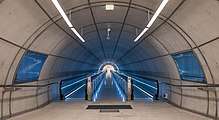
- MetroBilbao Convenient, Norman Foster designed Metro. It is clean and efficient, and security guards are often in evidence to reassure the public. Single line within Bilbao, splitting into two lines after San Inazio station. Line one runs from Etxebarri to Plentzia; line two from Etxebarri to Santurtzi. Trains run every couple of minutes at peak hours, and the stations are mostly very close together, meaning a lot of stops if you are going on a long journey. Tickets cost from €1.40-1.60, depending on how many zones your journey covers, or a daily card is available for €4. If using the Barik card, place your card over the reader in order to enter at the automatic gates, and do this again at the end of the journey when exiting.
- Bilbobus City bus service.
- Euskotren Tranbia A green tram from Atxuri Station to Basurto. The single line runs along the river passing the Bilbao Guggenheim Museum. Single tickets cost €1.15, and are sold from machines at tram stops. Don't forget to validate the ticket before boarding. If using the Barik card, swipe it once per passenger before boarding: do not re-swipe it at the end as it will have already debited your card with the flat fare.
- EuskoTren Local train service leaving from Atxuri Station for Bermeo, Guernica/Gernika and San Sebastian (Donostia). Some good views but the train is slower than buses. The Barik card cannot be used.
- BizkaiBus For buses which operate outside Bilbao city limits.
- 🌍 Artxanda Funicular. Spectacular views of Bilbao. The Barik card can be used on this service.
On foot
It takes about 30 minutes to walk along the river between the Guggenheim Museum and the Casco Viejo.
By taxi
Taxi Bilbao: Tel: +34 944 448 888. This single number is used by all taxi operators in Bilbao. Your cab should appear within five minutes.
See
Museums
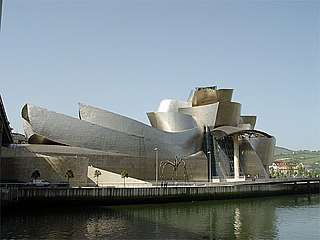
- 🌍 Guggenheim Museum, Abandoibarra etorbidea, 2. Tu-Su 10:00 to 20:00; Jul and Aug: daily 10:00 to 20:00. Closed Jan 1 and Dec 25. Frank Gehry's spectacular twisting titanium-clad modern art museum is perhaps the most celebrated building of the 1990s, even starting what would be called the 'Bilbao-effect': The idea in urban planning that a star-quality building can single-handedly change the entire image of a city. Although this effect is unproven in its pure form, the Guggenheim nevertheless changed the world wide perception of Bilbao. The graceful, sensuous curves, evocative of the ships that used to be ubiquitous along the docks of Bilbao, are covered in titanium squares, which resemble the scales of a fish and shimmer in the sunlight. In keeping with the maritime theme, appropriate for the setting, the skylights of the largest gallery (formerly known as the Fish gallery) are designed to look like the fins of fish. Many parts of the building are purely decorative, and don't serve any purpose. The permanent collection is not particularly impressive, but the museum always hosts at least one interesting temporary exhibit, frequently comprised of masterpieces from the other Guggenheim collections. Adults €13.00; students under 26: €7.50; children under 12: free.
- 🌍 Museo de Bellas Artes (Museum of Fine Art), Plaza del Museo, 2. Tu-Sa 10:00-20:00; Su and public holidays 10:00-14:00; M closed. 1 Jan and 25 December: closed. The Museum of Fine Art's remarkable collection boasts more than 6,000 works dating from the 12th century to the present day, and includes paintings, sculptures, drawings, engravings and decorative objects. General: €6.00; groups, students, senior citizens and unemployed: €4.50. Free of charge on Wed, and for children under 12. Artean Package, €13.50 (tickets for both the Guggenheim Museum and the Fine Arts Museum). Prices change for special exhibitions..

- 🌍 Basque Museum (Euskal Museoa), Plaza Unamuno, 4. Tu-Sa 11:00-17:00, Su 11:00-14:00. Mondays and public holidays: closed. Established in 1921 to focus on the prehistory, archaeology, ethnography and history of Euskadi (Basque homeland). Not a particularly well laid out museum. It will be of passing interest to people who study Basque culture. Adults: €3; students and groups €1.50. Children under 10 and seniors: free. Th: free.
- 🌍 La Ría Maritime Museum, Muelle Ramón de la Sota, 1. Winter: Tu-F 10:00-14:00, 16:00-18:00, Sa Su 10:00-14:00 and 16:00-20:00; summer: call to check. It's in what used to be the Euskalduna shipyard, next to the current Euskalduna Performing Arts Center. The museum covers an area of 27,000 m², 7,000 m² for indoor exhibitions and 20,000 m² for outdoor exhibitions, the three docks, the walkway surrounding them and the estuary. Adults: €5; Students, people over 65: €3.50. Children under 6: free of charge.
- Museo Taurino (Bullfighting Museum), ☎ +34 94-444-8698. Martín Agüero, 1, Plaza de Toros de Vista Alegre, (Near Plaza Zabalburu). Next to a bullring, the Museo Taurino highlights the role bullfighting has played in Euskadi. €3.
- 🌍 Museo Diocesano de Arte Sacro (Museum of Sacred Art), Plaza de la Encarnación, 9-B, Atxuri, ☎ +34 94-432-0125. A former convent founded in 1515 by Dominican nuns. General: €2. Students, seniors, and under 18: €1. Free on Thursdays.
- 🌍 Museo de Reproducciones Artísticas (Museum of Artistic Reproductions), Conde Mirasol (no number), ☎ +34 94-415-7673. Full-scale reproductions of the world's most famous works of art. Call ahead for a guided visit.
Churches
- Cathedral of St. James (Santiago). Gothic-style 14th-century cathedral, named after Bilbao's official patron saint. Three naves and small Gothic cloisters. The building was designated a cathedral in 1949. Its Neo-gothic tower and main façade were designed by Severino de Achúcarro in the 1800s. The adjoining square (Plaza de Santiago) bosts a fountain designed by Luis Paret during the reign of Carlos III with the inscription Por el bien público (For the good of the people).
- 🌍 Iglesia de San Antón. Gothic style church from the first half of the 15th century (1422). Dedicated to San Anton in the 16th century, the building is a mixture of styles including a renaissance portico and baroque tower which was built in 1777. The church was constructed on the ruins of a former alcazar, and is shown on Bilbao's shield.
- 🌍 Basílica de Begoña, C\ Virgen de Begoña, ☎ +34 944 12 70 91. Overlooking Bilbao, this is perhaps the most symbolic religious building in the city. Built in the 16th-century by Sancho Martinez de Arego, who was also responsible for the Iglesia San Anton. It is a basilica of three naves. During the first Carlista War, in 1835, the façade and the tower were destroyed. The present ones were designed Jose Maria Basterra and constructed between 1902 and 1907.
- Iglesia de San Nicolás, Esperanza, 1 (Arenal, Casco Viejo), ☎ +34 94 416 1424. The Iglesia de San Nicolás, finished in the 19th century, is dedicated to the patron saint of sailors. One of the best examples of Baroque architecture in Vizcaya.
- Iglesia de San Vicente Martir (Plaza de San Vicente), ☎ +34 94-423-1296. Gothic church built in the 16th century.
Other places of interest

- 🌍 Vizcaya Bridge. Also known as Puente Colgante (the hanging bridge), this is the only UNESCO World Heritage site in Spain listed in the "Industrial" category.
- 🌍 Alhondiga. An amazing building which has recently modernized (according to designs by Philippe Starck and Thibaut Mathieu). It is an amazing complex containing a library, several bars and restaurants, a cinema and even a roof swimming pool with a glass floor! A must visit!
- 🌍 A flower puppy. Just in the front of the Guggenheim Museum, created by Jeff Koons, it's one of the most famous symbols of modern Bilbao
- Birthplace of Miguel Unamuno, c/La Ronda 16 (Next to Plaza Unamuno, Metro station: Casco Viejo). Spanish author born on 29 September 1864. His works include the novels Niebla and San Manuel Bueno, Martir, which are both read in AP Spanish Literature classes in the United States. Unamuno died on 31 December 1936 in Salamanca.
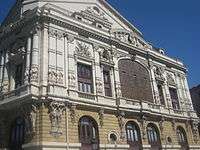
- 🌍 Teatro Arriaga, ☎ +34 94-435-5100. Inaugurated on 31 May 1890, on the site of several former theaters, the first Teatro Arriaga burnt down on 22 December 1914. The second Teatro Arriaga opened on 5 June 1919. Evocative of the Opera House in Paris, the theater has an ornate façade and beautiful interior. The theater, and the square in front of it, were named after Juan Crosótomo de Arriaga, a composer from Bilbao. There is a tourist information office in the theater building: the entrance is on the left side as you face the theater.
- Estación de Santander (Santander Station, FEVE Station). Also known as La Concordia, it was built between 1898-1902 on the banks of the Nervión. Designed by the engineer Valentín Gorbeña, with the art nouveau main façade added later with a design by the architect Severino Achúcarro.
- 🌍 Estación Abando (RENFE station) (Next to Santander Station). Even if you are not going to take a train, visit the platforms, there is an impressive stained glass atrium depicting some traditional Basque jobs.
- 🌍 Puente de San Antón. Next to the Iglesia de San Antón sits Bilbao's most emblematic bridge.

- Mercado de la Ribera. Another emblem next to the Iglesia de San Antón is the Mercado de la Rivera. One of the biggest covered markets in Europe. It was built in 1929 on the site of the original Rivera Street market. Produce fish and meat are sold in the market every morning, except Sundays.
- 🌍 Plaza Nueva. Bilbao's Plaza Nueva was first named Plaza de Fernando VII. Construction began on the plaza on December 31, 1829 and finished exactly 20 years later on December 31, 1849. This plaza was the seat of the Diputación de Vizcaya until July 1900 when the Diputación moved to its new home on the Gran Vía. The Academy of the Basque Language (Euskaltzaindia) occupies the old Diputación building in the Plaza Nueva. There is a market of used books, stamps, coins, and other small items in the plaza every Sunday morning. The Plaza Nueva is surrounded by buildings and only has entrances on some sides.
- 🌍 Palacio de la Diputación. Ornately decorated palace situated on the Grand Vía. Baroque-style monument designed by Luis Aladrén in 1897 to serve as the seat of the Diputación Foral de Bizkaia (Vizcaya) and inaugurated on July 31, 1900. The interior is just as lavish as the exterior, with beautiful stained glass windows.
- 🌍 Palacio Euskalduna (Euskalduna Conference Center and Concert Hall). A convention center and concert hall housed in a modern building at the far end of paseo Uribitarte. Home to the Bilbao Symphony Orchestra and Bilbao Opera.
- 🌍 Plaza Moyua and Gran Vía. On the strech of the Gran Vía between Plaza Abando and Plaza Moyua is the main shopping and fashion district of Bilbao. On this short stretch you can find tons of clothes shops (For, Zara, Mango, H&M) as well as department store El Corte Ingles. This is a must-walk street.
- 🌍 Parque Etxebarria. The site of a former steel factory, this park was created in the 1980s as the first step of reorienting Bilbao from the industrial sector to the service sector. Wonderful views of the Casco Viejo and the Teatro Arriaga. There is a prominent chimney in the park, left over from the site's time as a factory. The park hosts a fun fair in August.
- 🌍 Ayuntamiento (City Hall), Plaza Ernesto Erkoreka, ☎ +34 94-420-4200. Also known as la Casa Consistorial or Udaletxea. The city hall opened in 1892. Designed by architect Jaquin Rucoba in neo-baroque style. Don't miss the main reception area, called Arab Salon.
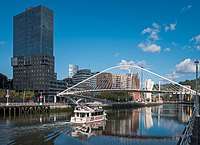
- 🌍 Zubizuri. The graceful white pedestrian bridge designed by Santiago Calatrava, actually zubi zuri means white bridge in Basque. It spans the Nervión connecting the riverwalks Campo Volatin and Mazarredo. Be careful, the bridge is slippery when wet!
- 🌍 El Tigre. Tiger statue on top of a building in Deusto. Seen from Euskalduna Performance Center.
- 🌍 Bilbao Airport. Curvaceous white 'bird-like' building by Santiago Calatrava. Strangely missing an arrival hall.
- 🌍 Biblioteca Municipal de Bidebarrieta, Bidebarrieta, 4 (Casco Viejo, near Teatro Arriaga), ☎ +34 94-415-6930. Commissioned by El Sitio society at the end of the 19th century, this building was built by architect Severino de Achucarro as a social hall. Now home to the city's historical archives and library.
- 🌍 Palacio de Ibaigane, Alameda Mazarredo, 23, ☎ +34 94-424-0877. Home to the Athletic Club de Bilbao, Bilbao's football team. Built in the early 20th century. Note the arched entranceway. The nearest metro stop is Moyúa.
- Palacio de Olábarri (Palacete del Puerto Autónomo de Bilbao), Campo Volantín, 37, ☎ +34 94-487-1200. An interesting mix of several architectural styles. In the late 19th century it was the residence of Bilbaino entrepreneur José María de Olábarri. Now the seat of Bilbao's port authority.
- 🌍 Santa y Real Casa de la Misericordia, Sabino Arana, 2 (Next to Plaza del Sagrado Corazón), ☎ +34 94-441-1900. Constructed in the mid-19th century as a charitable house for the poor.
Do
- In the summer see an open air concert at the Kiosko del Arenal El Arenal Parque (across from Plaza Arriaga). The stage was built in 1923, and renovated in 1985.
- Beginning the first Saturday after August 15 and lasting for 9 days is Aste Nagusia / Semana Grande, the city's fiesta (holiday). An interesting time to come, but be prepared for lots of noise, music, street theater and events, with firework displays in the evening. Details from the tourist office in Teatro Arriaga.
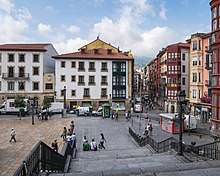
- Walk through the seven streets of the old town Casco Viejo.
- Climb the Mallona stairs from Plaza Unamuno to Parque Etxebarria for the great views.
- Walk along the river.
- Walk through Doña Casilda Iturrizar Park, admiring the ponds and gardens, next to the Fine Arts Museum.
- Take the Artxanda Funicular, again for the views.
- Go kayaking or rent a boat from Bilbobentura (a company that rents out kayaks on the bank of the river nervion).
- Watch football ie soccer at Athletic de Bilbao. They play in La Liga, the top tier of Spanish football, and indeed (along with Barcelona and Real Madrid) have never been relegated from it. They're noted for only signing players native to the Basque Country. Their home ground is the new San Mamés stadium, capacity 53,000, on the river bank 2 km northwest of city centre: it's opposite the Termibus station and has its own Metro & local rail station.
- First Saturdays Flea Market. Dos de Mayo Street transforms every first Saturday into a flea market selling antiques, books, and second hand clothes.
Buy
Clothes and shoes
- Hazel, Rodriguez Arias 4, ☎ +34 944 793 325. 10AM-8PM. Gorgeous shoes, simple but unique and pretty bloody affordable clothes.
- Falstaff, Colon de Larreategui 29 (Abando), ☎ +34 944 233 598. 10AM-8PM. Stylish clothes for fashion conscious women of all ages.
Eat
Pintxos
The local custom is to call what are known in Spanish as tapas by the Basque name, pintxos, probably much more elaborated than their Spanish cousins due to the Basque love of gastronomy.
Friday and Saturday nights are most popular time for eating pintxos - as it is for going to bars.
- Aritz, Calle Zugastinobia 4. Was once one of the best Pintxos bars in Bilbao, quite out of the way (almost hidden really in a very small, one way street away from the main thoroughfares). Ask for it and you will be given directions. It is worth the walk since they have won the local Pintxo contests for ages. Closed as of Feb 2008 and as the summer of 2008 reopened with what appears to be new management with less emphasis on its prize-winning pintxos. It's worth going to this street though because there are dozens other pintxos bars.
- Restaurante Kasko, c/Santa María, 16, ☎ +34 94 416 0311. This restaurant claims that their Pintxos are a miniaturization of Basque cooking culture. The Pintxos are presented very nicely and in an appetizing way on the bar counter. Staff proficient in English, occasionally live Piano music. Can be crowded at times.
Plaza Nueva
- Bilbao Cafe bar, Plaza Nueva, 6, ☎ +34 94 415 16 71.
- Charley Bar, Plaza Nueva, 8, ☎ +34 94 415 01 27.
- Fernando, Plaza Nueva, 12, ☎ +34 94 415 05 64.
- Víctor, Plaza Nueva, 2, ☎ +34 94 415 1678.
Near the Diputación
- El Globo, c/Diputación, 8, ☎ +34 94 415 42 21.
- La Viña del Ensanche, c/Diputacion, 10, ☎ +34 94 416 53 58.
Restaurants
- à table, Dos de Mayo 18, ☎ +34 944154766. Cozy place in the old quarter of Bilbao. An authentic Basque-French restaurant offering a true flavour of that traditional cuisine. Good cellar. Reservation required. Service in English.
- Agape, c/Hernani, 13, ☎ +34 94 416 05 06.
- Batzoki Bilbao, c/Tendería, 17, ☎ +34 94 679-2230. Located in the first floor above a popular Pintxos-bar. Great evening menú de degustación on weekends offering lots of tasty starters, a main plate (can be chosen from several options), an assortment of desserts and a bottle of D.O. Rioja for about €30. Very friendly and helpful service, nice quiet dining atmosphere.
- Harrobia, casco viejo; c/del Perro, 2, ☎ +34 944 134 013. Modern Basque cooking.
- Matxinbenta, c/Ledesma 26, ☎ +34 94 424-8495. M-Sa 08:00-23:30. Basque food, specialities include fresh tuna in piquant tomato sauce and piperada. Reservations required.
- Zortziko, c/Alameda de Mazarredo 17, ☎ +34 94423-97-43, +34 944 23-63-96. Tu-Sa 09:00-23:30. Traditional Basque dishes such as pigeon breast or marinated sea bass. Formal environment with late Victorian style furnishing, frequently booked days in advance. Ask about reservations to dine in the wine cellar.
Drink
Tap water is safe to drink, also from the outdoor taps if not clearly marked with signs saying No Potable (not potable). On weekend nights a lot of people gather in the bar area in eastern Casco Viejo, get their drinks from any of the bars and hang around on the streets before heading to nightclubs.
- Bar Jamon Jamon, c/Luis Power 3, Deusto (Deusto Metro Station), ☎ +34 944 47 65 94. Simple neighbourhood bar. Good ham baguettes (bocadillo). Freshly baked baguettes, counter-carved Spanish Ham and the friendly service of Luis and Nekane. Not fancy but familiar with authentic atmosphere.
- Cafe Nervión, c/La Naja 7. Wonderful views of the river.
- Lamiak, c/De la Pelota (Casco Viejo). Comfortable coffee house, with chocolate cake to die for.
- Three spectacularly decorated bars (which are owned by the same people) are:
- Cafe Iruña, c/ Colon de Larreategui 13. With its Arabesque motifs and antique mouldings it is a sight to behold. If you go at night, you can also get some nice shikabobs - some of the only ones you'll find in Bilbao.
- Cafe La Granja (in Plaza Circular, across from the BBVA tower).
- Cafe Boulevard (on the Arenal, across from Teatro Arriaga).
- Kafe Antzokia, San Vicente 2, ☎ +34 94 424 46 25. This former theatre was converted into a multi-purpose venue in 1995. It is best known for promoting the Basque culture, both as an artist’s venue and for the clientele. With a varied schedule of concerts of Basque and international bands, it serves as a night club on weekends. Run by a cultural association aimed at promoting the use of Basque language, it also hosts a restaurant, a Basque academy and a community radio station.
- Bar Juantxu, c/ Licenciado Poza, 39.
- Dakar, C/ Heros, 13, ☎ +34 94-424-9756. Nightly karaoke and Spanish dance music.
- Galeon, Alda. Mazarredo, 25, ☎ +34 94-423-1462. Maritime motif a mermaid statue at the entrance and decoration resembling the inside of a ship.
- Gran Casino Nervión, C/ Navarra, 1, ☎ +34 94-424-0007. Two bars, on-site restaurant. Formal/semi-formal dress required.
- La Mutua, C/Ercilla, 2, ☎ +34 94-423-1154. Serving breakfast during the day, and reopening at 23:30 for the night.
- Otxoa, C/Lersundi, 8, ☎ +34 94-424-1848.
- Panko. Great stylish place that sells bread, pinxtos and meals. Good selection of regional wines
Sleep
Budget
There are many inexpensive Pensions in the Casco Viejo.
- Albergue Bilbao, Ctra Basurto-Kastrexana, 70, ☎ +34 94 427 00 57. A youth hostel with 48 rooms (22 double rooms). A bit of a journey away from the center, but connected by bus.
- Bilbao Akelarre Hostel, Morgan 4-6, ☎ +34 94 405 77 13. “Bilbao Akelarre Hostel” is the first and private youth hostel in Bilbao designed for you.It is just a few minutes by walking from the Guggenheim Museum,located in the historic district of “Deusto University”. €17-21.
- Ganbara Hostel, Prim 13, ☎ +34 94 405 39 30. “Ganbara Hostel” is the only hostel in the “Seven Streets” area: the very heart of the Old Town district of Bilbao. This makes it the ideal spot for anyone who wants to keep their finger on the pulse of the city: it is close to most of the museums and monuments, to the venues of the city’s cultural activities and to its night-life hot-spots.
Mid-range
- NH Palacio de Oriol, Avda. Cristobal Murrieta, 27, 48980 Santurtzi, ☎ +34 94 4934100, fax: +34 94 4837890. Overlooking the Abra Bay, the hotel occupies a palace built in 1902.
- Holiday Inn Express Bilbao, Zarandoa Kalea 5, ☎ +34 944-868240. Brand new contemporary hotel located close to Bilbao Airport and only 10km from the city centre.
Splurge
- 🌍 Carlton, Plaza Moyua 2, ☎ +34 94 416 22 00, fax: +34 94 416 46 28, e-mail: carlton@aranzazu-hoteles.com.
- Melia Bilbao, Lehendakari Leizaola 29, ☎ +34 94 428 00 00, fax: +34 94 428 00 01, e-mail: melia.bilbao@melia.com.
- Miró Bilbao, Alameda Mazarredo 77, ☎ +34 94 661 18 80, fax: +34 94 425 51 82, e-mail: infoo@mirohotelbilbao.com.
- Barceló Nervión, Campo Volantin 11, ☎ +34 94 445 4700.
- Conde Duque, Campo Volatin 22, ☎ +34 94 445 6000.
- Hotel Ilunion, Calle Rodriguez Arias 66 (It's quite near the Bus Terminal, very near to the metro and quite near to the Guggenheim museum.), ☎ +34 94 441 3100.
Stay safe
With a rate of only 33.4 crimes per 1000 inhabitants, the Basque Country has one of the lowest crime rates in Europe.
Crime rates can, however, vary significantly between rural and urban areas, though urban areas are still not particularly dangerous. Avoid the San Francisco area, however. Violent crime is extremely rare, but the usual precautions will keep you out of trouble.
While some may advise you not to wear any Spanish symbols, the reality is that the vast majority of Bilbainos will not even notice, much as it is true that a small minority might be upset about them. As a statistical precaution it is also best to avoid referring to the Basque Country as Spain.
Take into account that inhabitants of the Basque Country are divided between those who support independence or autonomy from Spain and consider themselves primarily or entirely Basque and others who consider themselves primarily or entirely Spanish. Within these currents, there are further subdivisions of opinion ranging from supporters of the terrorist group ETA (officially disbanded in 2018) at one end to those who supported the fascist regime of General Franco at the other (though an overwhelming majority of people fall somewhere in between these extremes).
These political issues have dominated life in the Basque Country for generations and you will still find coverage of them in news media across the Basque Country every day. Also certain bars will have a distinctly Basque nationalist clientele (such bars will generally have posters and slogans on the walls) where pro-Spanish opinions will be unwelcome, but which are otherwise perfectly safe places to go and indeed interesting to anyone who would like to learn more about the Basque identity. If speaking to strangers, bear these divisions in mind and try not to cause offence.
Cope
Consulates


Go next
Biscayan Towns
- Balmaseda Charming town an hour from Bilbao
- Guernica - Gernika—Basque stronghold town, bombed by the Nazis during the Spanish Civil War. Inspired Guernica by Picasso in the Museo Reina Sofia in Madrid.
- Mundaka Medieval port and famous surf spot.
- Sopelana Town near the beach, can be reached directly from the city by MetroBilbao.
- Portugalete Take the Transporter Bridge from Getxo to this charming town.
- Plentzia Another town near the beach, can be reached directly from the city by MetroBilbao.
- Getxo Very nice walk along the coast, from the bridge to Sopelana. More than 10 km long.
- San Juan de Gaztelugatxe—Small chapel situated on a breathtaking island between Bakio and Bermeo.
Cities in other provinces
- San Sebastian — Beautiful resort with bar counters full of tasty Pintxos (Tapas)
- Santander — Resort City
- Vitoria-Gasteiz – Capital of the Basque Autonomous Community, green city with a nice old town